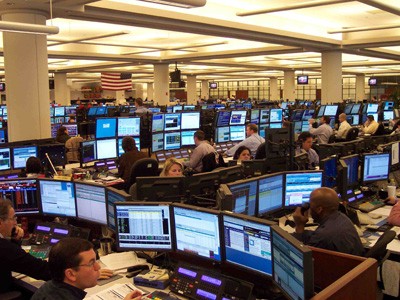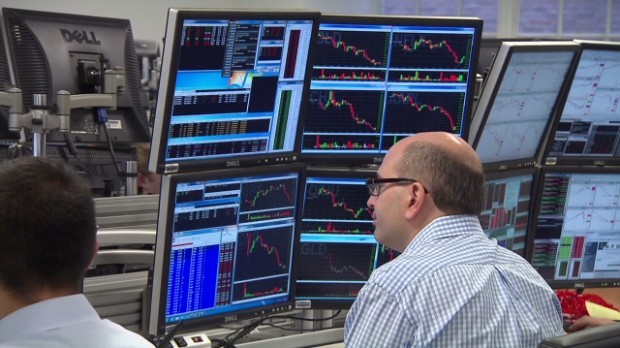Day Trading
Post on: 21 Август, 2015 No Comment

Day trading
  Image. A professional day
  trader sitting at his desk.
 
Download our free day trading course HERE
What is day trading?
It is a trading method that utilizes both technical and fundamental analysis
to uncover short term bullish trade or bearish signals in real times.  It aims to profit from
short term market cycles without dwelling too long in the market.
A day trade may last for fifteen minutes up to two hours in normal market conditions.
Who are day traders?
These are market players that use technical indicators such as the slow stochastic. Moving Average Convergence Divergence indicator ( MACD ), Relative Strength Index ( RSI ), or the CCI indicator to spot real times buy or sell trading signals without disregarding the trading triangle.  They also employ chart market patterns. Elliott wave structures and Fibonacci patterns.  Apart from these, more advanced short term traders also make use of fractal trading strategies to forecast the next price move.
Day traders are the most active market participants since they are constantly placing orders.
More working traders can place more than hundred trades per day depending on their trading style or account.  
There are regular day traders, but also professional traders who trade for hedge funds, banks, trading firms and big financial institutions such as J. P. Morgan or Goldman Sachs.  Common short terms traders are less in action than the professionals for the reason that most are part time short term traders with minuscule trading accounts.
Day-traders buy or sell stocks, currency pairs ( Forex or FX), commodities, indices and ETF.  As real times market participants, they spend most of their time looking at their computer screens.  A day-trader can spend at least three hours starring at computers screen when he or she is trading.   
Day trading tools
Most daily traders use mechanical trading systems such as the TSTW 24. TS CCI PRO or Swing 240.  The systems allow them to apply viable trading strategies without guessing the market.
They also help them to stay focused, disciplined and detached from all unnecessary emotional
or irrational reactions.  Furthermore, they as well rely on automated trading software such as Track ‘n Trade Autopilot . 
Though, these trading tools are essential, the most imperative trading instrument is the trader.
He or she has got to be able to filter out false signals or distortions and take into consideration the current market environment.  A trader will also pay heed to all economic news at Google finance. Yahoo finance or Forex factory .  One shall always trade guardedly when high impact news such ADP Non-Farm Employment Change or Non-Farm Employment Change.
Real times traders bring into play various trading strategies depending on the financial instruments that they are trading.  The most effective strategies are the three channels trading methods which do not violate the market patterns.  Day traders also specialize in a particular market or financial security.  Some do trade stocks while others only trade Forex or commodities.  In addition, there are also specialists for a single financial instrument such as the Euro-dollar currency pair, silver or gold.
Day trading pitfalls
a/ The number one pitfall is over trading when a trader becomes too greedy and exposes more than 5% of his or her trading account.   
b/ Lack sufficient trading fund.
c/ Lack of a viable trading plan or strategy.
d/ Constant violation of market patterns.
e/ The use of a single time frame instead of a multiple time frames trading strategy.
f/ Bad habit of repeating the same common trading mistakes over and over without caring.
h/ No consideration to the economic news at Google finance, Yahoo finance and Forex factory.
I/ No desire to learn to apply the trading triangle.
j/ Impatience; one never waits for a price candlestick bar to close before looking for signals or always rushing to place a trade

k/ No viable money management or hedging strategy.
l/ Setting the wrong goal such as making money instead of one that seeks to trade successfully
   like a pro.   Indeed, trading like a pro will permit one to profit from the financial markets.
m/ No attention to London, New York or Hong Kongs opening bell.
n/ Addiction to be in a trade even if the trade setup is not reliable.
p/ Being a courageous trader instead of a smart trader.
q/ No knowledge of basic market protocols that the professionals follow.
Final points
It is essential for beginners to remain composed, and stop blaming themselves too much for these downfalls.  New traders are more likely to commit these errors without knowing, but it is indispensable to review all losing trades.  If one had a losing trade, one ought to know what went wrong.  Once one identifies the source, one will now try to rectify it or control it if it arises in the future.
For example if a day trader does not acknowledge the opening bell and notices that this is one the causes of his or her trading failure, he or she will learn to be patient or wait at least thirty minutes after a market is open before pulling the trigger.
It is vital to all active market participants to watch the full length of each educational day trading tutorial .
These trading tutorials have been carefully prepared to help day traders who want to boost their trading skills.  These are practical demonstrations with effective day trading strategies that one can learn and master.
Finally, one ought to understand that it takes time to become an expert.  Therefore, one will engage one step at a time making sure that one grasps the first level before heading to the next.  The learning curve varies from one trader to another, but nothing can stop those who want to adopt the mindset of a professional day trader.
   Image = A day trading picture
   showing a day trader analysing
   a chart.
Watch all the best day trading strategies video tutorials HERE














